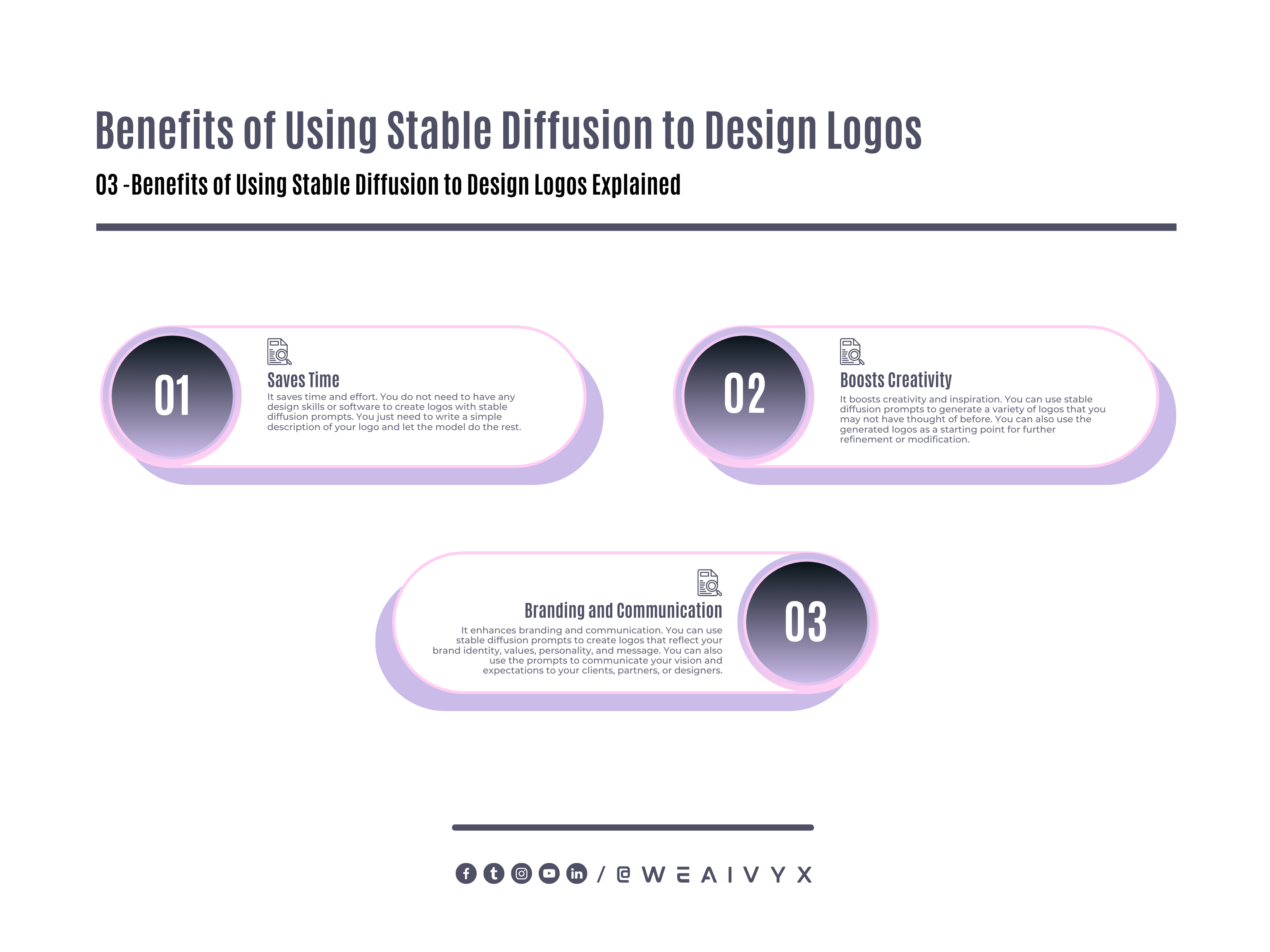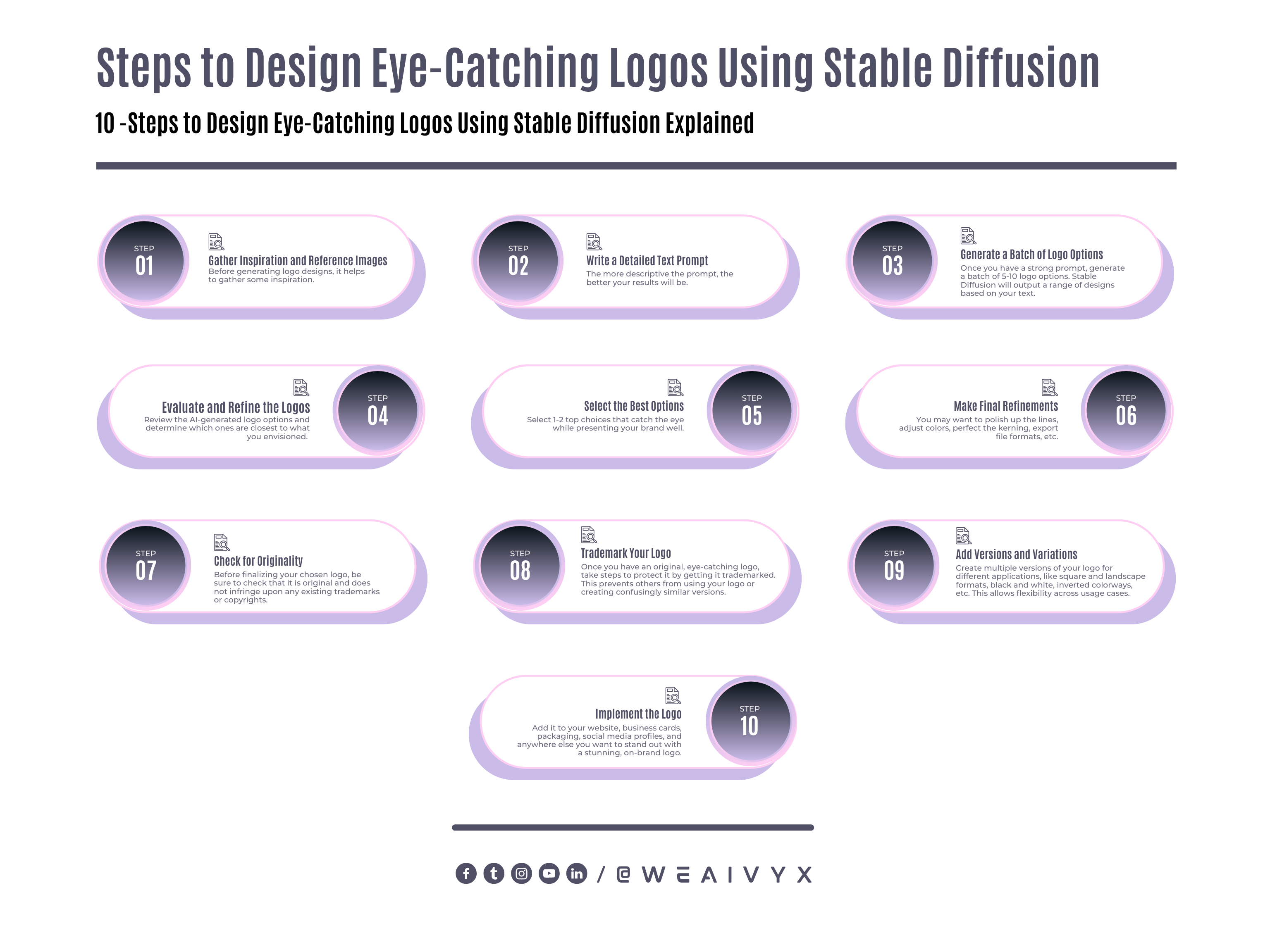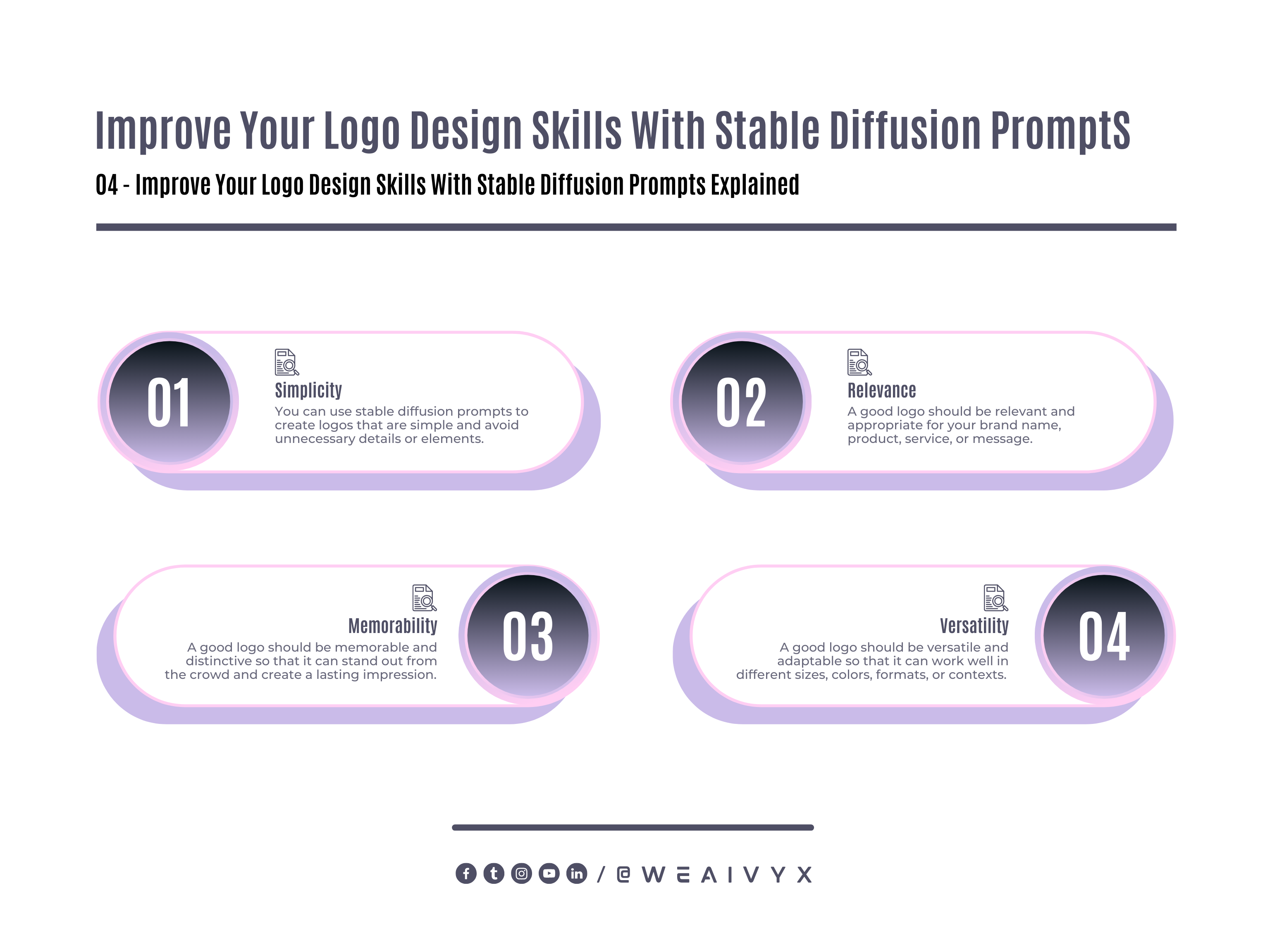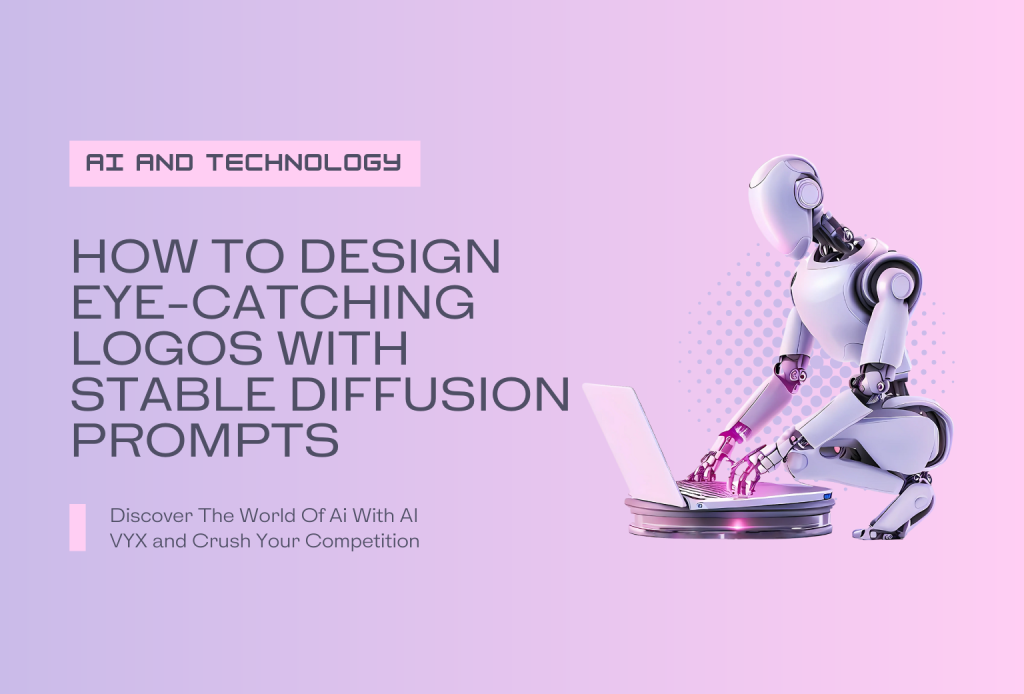Logos are one of the most important elements of branding. They help to create a visual identity for a company, product, or service, and convey its values, personality, and message.
A good logo can make a lasting impression on customers and differentiate a brand from its competitors.
But how can you design a logo that is eye-catching, memorable, and relevant?
One possible way is to use stable diffusion prompts, a technique that leverages artificial intelligence to generate images based on textual descriptions.
In this blog, we will explain what stable diffusion prompts are, how they work, and how you can use them to create stunning logos for your brand.
What Are Stable Diffusion Prompts?
Stable diffusion prompts are a type of art prompt that can be used to create images with an AI model called Stable Diffusion.
Stable Diffusion is a generative model that can produce high-quality and diverse images from scratch or an input image.
It works by gradually adding noise to an image until it becomes completely random, and then reversing the process by removing noise and restoring the original image. This process is called diffusion.
Stable diffusion prompts are textual descriptions that guide the diffusion process and influence the output image.
They can specify the content, style, color, shape, and other attributes of the desired image.
For example, a prompt like “a blue dragon with red eyes and scales” would tell the model to generate an image of a dragon that has those features.
Stable diffusion prompts are different from other types of art prompts, such as VQGAN+CLIP or DALL-E, in several ways.
First, stable diffusion prompts are more natural and intuitive to write, as they do not require any special syntax or keywords.
Second, stable diffusion prompts are more flexible and expressive, as they can combine multiple concepts and modifiers in one prompt.
Third, stable diffusion prompts are more robust and consistent, as they can handle complex and ambiguous prompts without producing artifacts or errors.
How Does Stable Diffusion Prompt Work?
Stable diffusion prompts work by using natural language processing (NLP) techniques to extract semantic information from the prompt and map it to visual features in the image.
The model uses a pre-trained language model called CLIP to encode the prompt into a vector representation that captures its meaning.
Then, it uses a neural network called StyleGAN2 to generate an image that matches the prompt vector.
The model also uses a technique called style mixing to blend different styles of images based on the prompt.
For example, if the prompt contains two different concepts, such as “a dragon” and “a flower”, the model will mix the styles of images that represent those concepts and create a new image that combines them.
This way, the model can generate novel and creative images that are not limited by existing data.
How Can You Use Stable Diffusion Prompts to Design Logos?
Stable diffusion prompts can be used to design logos by providing a brief description of your brand name, product, service, or message, and adding some modifiers to specify the style, color, shape, or other features of your logo.
For example, if you want to design a logo for a brand called Noxu that sells jigsaw puzzles, you could use a prompt like “Noxu in a puzzle font with colorful pieces”.
This would tell the model to generate an image of the word Noxu written in a font that looks like puzzle pieces and use different colors for each piece.
You can also use stable diffusion prompts to explore different variations of your logo by changing or adding some words to your prompt.
For example, if you want to design a logo for a brand called Noxu that sells jigsaw puzzles, you could use a prompt like “Noxu in a puzzle font with colorful pieces”.
For example, you could try different fonts, colors, shapes, or backgrounds for your logo by using words like “cursive”, “red”, “circle”, or “gradient”. You could also try different concepts or themes for your logo by using words like “nature”, “space”, “fun”, or “elegant”.
You can experiment with different combinations of words and see what kind of images the model generates.
Here are some examples of logos generated by stable diffusion prompts:
Noxu in a puzzle font with colorful pieces
Noxu in cursive with a gradient background
Noxu in space with stars and planets
Noxu in nature with leaves and flowers
Noxu is fun with balloons and confetti
Noxu is elegant with gold and silver
What Are the Benefits of Using Stable Diffusion Prompts to Design Logos?
Using stable diffusion prompts to design logos has several benefits:
Saves Time
It saves time and effort. You do not need to have any design skills or software to create logos with stable diffusion prompts. You just need to write a simple description of your logo and let the model do the rest.
Boosts Creativity
It boosts creativity and inspiration. You can use stable diffusion prompts to generate a variety of logos that you may not have thought of before. You can also use the generated logos as a starting point for further refinement or modification.
Branding and Communication
It enhances branding and communication. You can use stable diffusion prompts to create logos that reflect your brand identity, values, personality, and message.
You can also use the prompts to communicate your vision and expectations to your clients, partners, or designers.

How to Design Eye-Catching Logos Using Stable Diffusion
Stable Diffusion is a new AI system that can generate realistic images and artwork from text prompts. With some creativity, it can be used to design unique, professional logos.
I’ll walk through the step-by-step process for using Stable Diffusion to create custom logos that catch the eye.
1. Gather Inspiration and Reference Images
Before generating logo designs, it helps to gather some inspiration. Look at logos in your industry or for brands you admire.
Take note of colors, shapes, fonts, and stylistic elements you may want to incorporate.
Save reference images to show the AI examples of what you’re going for.
2. Write a Detailed Text Prompt
Stable Diffusion generates images based on the text prompts you provide. The more descriptive the prompt, the better your results will be. Include details like:
The company or brand name
Adjectives to describe the style you want (minimalist, abstract, retro, modern, etc)
Colors, shapes, symbols, or other design elements to include
Any other stylistic flourishes or textual elements Take time to write and refine your prompt for the best results.
3. Generate a Batch of Logo Options
Once you have a strong prompt, generate a batch of 5-10 logo options. Stable Diffusion will output a range of designs based on your text.
4. Evaluate and Refine the Logos
Review the AI-generated logo options and determine which ones are closest to what you envisioned. Look for designs that are visually striking but also align with your brand identity.
Go back and tweak the prompt to improve upon the logos.
Generate new batches using updated prompts that refine elements like color schemes, fonts, shapes, etc.
5. Select the Best Options
After multiple iterations of generating and refining, you should have some high-quality logo options to choose from. Select 1-2 top choices that catch the eye while representing your brand well.
6. Make Final Refinements
Download the best logos and make any final tweaks in a design program like Illustrator or Photoshop.
You may want to polish up the lines, adjust colors, perfect the kerning, export file formats, etc. This helps finalize the logos.
7. Check for Originality
Before finalizing your chosen logo, be sure to check that it is original and does not infringe upon any existing trademarks or copyrights.
Google image search your logo to see if it appears elsewhere or is too similar to another brand’s design.
8. Trademark Your Logo
Once you have an original, eye-catching logo, take steps to protect it by getting it trademarked. This prevents others from using your logo or creating confusingly similar versions.
9. Add Versions and Variations
Create multiple versions of your logo for different applications, like square and landscape formats, black and white, inverted colorways, etc. This allows flexibility across usage cases.
10. Implement the Logo
Finally, put your polished logo to use across your brand presence! Add it to your website, business cards, packaging, social media profiles, and anywhere else you want to stand out with a stunning, on-brand logo.

Key Takeaways
Use Stable Diffusion to iteratively generate logo options based on descriptive text prompts.
Refine and polish the AI outputs to create professional, eye-catching logo designs
Make sure logos are original designs that align with your brand identity.
Finalize logos in a vector format and trademark them to protect your brand.
How Can You Improve Your Logo Design Skills With Stable Diffusion Prompts?
Stable diffusion prompts can be a useful tool for improving your logo design skills, as they can help you learn and practice some key aspects of logo design, such as:
Simplicity
A good logo should be simple and clear so that it can be easily recognized and remembered.
You can use stable diffusion prompts to create logos that are simple and avoid unnecessary details or elements.
Relevance
A good logo should be relevant and appropriate for your brand name, product, service, or message.
You can use stable diffusion prompts to create logos that are relevant and match your prompt description.
Memorability
A good logo should be memorable and distinctive so that it can stand out from the crowd and create a lasting impression.
You can use stable diffusion prompts to create logos that are memorable and use unique features or styles.
Versatility
A good logo should be versatile and adaptable so that it can work well in different sizes, colors, formats, or contexts.
You can use stable diffusion prompts to create versatile logos and test them in different scenarios.

Stable Diffusion Prompt Ideas
Here are some more example prompts for generating logo concepts with Stable Diffusion:
“Rounded sans-serif wordmark logo for a startup clothing brand selling modern basics, incorporate minimalist shapes and neutral earth tones”
“Monogram logo mark for a high-end watch company, combine bold serif letter with an abstract geometric shape, use black and gold colors”
“Retro 1980s style logo for a pizza restaurant, use vibrant neon colors, fun bubbly font, and a slice of pizza icon”
“Modern luxury hotel logo with Art Deco influences, incorporate symmetry, straight lines, metallic accents and shades of blue-grey”
“Logo for a children’s book publisher, use a colorfully illustrated book icon, hand-drawn storybook font, and a warm cozy color palette”
“Tech company logo with a futuristic look, angular glyph icon representing connectivity, electric blue, and neon purple colors”
“Bakery logo in a classic 1950s style, use a script font, images of bread or pastries, and soft nostalgic color palette”
“Minimalist and modern logo for a beauty brand with clean skincare aesthetic, subtle elegant font, white space”
“Bold and eye-catching logo for an energy drink, use bright neon colors, strong geometric shapes, and flashy chrome or gradient effects”
“Professional law firm logo that conveys trust and experience, traditional serif font, dark blue and grey colors, balanced visual weight”
What Are the Limitations and Challenges of Using Stable Diffusion Prompts to Design Logos?
Using stable diffusion prompts to design logos also has some limitations and challenges:
Trial and Error
It requires trial and error. You may need to try different prompts and tweak them until you get a logo that meets your needs and preferences.
You may also need to adjust the parameters of the model, such as the resolution, quality, or diversity of the images.
Model and Data
It depends on the model and data. The quality and diversity of the logos generated by stable diffusion prompts depend on the performance and training of the model and the data it uses.
The model may not be able to generate logos that are too specific, complex, or rare.
Originality or Legality
It does not guarantee originality or legality. The logos generated by stable diffusion prompts may not be original or unique, as they may be influenced by existing images or data.
They may also not be legal or ethical, as they may infringe on the intellectual property rights or trademarks of others.

Conclusion
Stable diffusion prompts are a powerful technique for generating images with artificial intelligence.
They can be used to design eye-catching logos for your brand by providing a textual description of your logo idea and letting the model generate an image that matches it.
You can also use stable diffusion prompts to explore different variations of your logo by changing or adding some words to your prompt.
Using stable diffusion prompts to design logos has many benefits, such as saving time and effort, boosting creativity and inspiration, and enhancing branding and communication.
However, it also has some limitations and challenges, such as requiring trial and error, depending on the model and data, and not guaranteeing originality or legality.
Stable diffusion prompts can also help you improve your logo design skills by teaching you some key aspects of logo design, such as simplicity, relevance, memorability, and versatility.
If you want to try stable diffusion prompts for yourself, you can use Fotor, a powerful AI image generator that supports stable diffusion prompts.
We hope this blog has given you some insights into how to design eye-catching logos with stable diffusion prompts.
